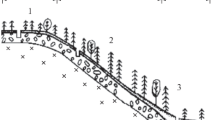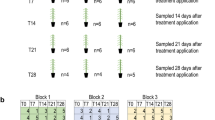Abstract
Long-term defoliation by budworms was associated with higher levels of soluble proanthocyanidins in the current year needles of Douglas-fir trees. The proanthocyanidin contents of needles from defoliated Douglas-fir trees were considerably more variable than those levels of undefoliated ones. The increased mean and variability of proanthocyanidin levels following defoliation may have interesting ecological consequences for Douglas-fir and its defoliators.
Similar content being viewed by others
References
Baldwin, I.T., andSchultz, J.C. 1983. Rapid changes in tree leaf chemistry induced by damage: Evidence for communication between plants.Science 211:277–279.
Bauer, P.S., andWalkinshaw, C.S. 1974. Fine structure of tannin accumulations in callus cultures ofPinus elliotti (slash pine).Can. J. Bot. 52:615–619.
Bernays, E. A. 1981. Plant tannis and insect herbivores: An appraisal.Ecol. Entomol. 6:353–360.
Denno, R.F., andMcClure, M.S. 1983. Variability: A key to understanding plant-herbivore interactions, pp. 1–12,in R.F. Denno and M.S. McClure(eds.). Variable Plants and Herbivores in Natural and Managed Systems. Academic Press, New York.
Cates, R.G., Redak, R.A., andHenderson, C.B. 1983. Patterns in defensive natural product chemistry: Douglas-fir and western spruce budworm interactions, pp. 3–19,in Paul A. Hedin, (ed.). Plant Resistance to Insects. American Chemical Society, Washington, D.C.
Dethier. V.G. 1982. Mechanism of host-plant recognition.Entomol. Exp. Appl. 31:49–56.
Hahlbrock, K., andGrisebach, H. 1975. Biosynthesis of flavonoids, pp. 866–915,in J.B. Harborne, T.J. Mabry, and H. Mabry (eds.). The Flavonoids. Academic Press, N.Y.
Haslam, E. 1981. Vegetable tannins, pp. 527–556,in P. K. Stumf and E. E. Conn (ed.). Biochemistry of Plants, Vol. 7. Academic Press, New York.
Haukioja, E., andNiemala, P. 1979. Birch leaves as a resource for herbivores: Seasonal occurrence of increased resistance in foliage after mechanical damage of adjacent leaves.Oecologica 39:151–159 (cited in Whitham, 1983).
Klocke, J.A., andChan, B.G. 1982. Effects of cotton condensed tannin on feeding and digestion in the cotton pest,Heliothis zea.J. Insect Physiol. 28(11): 911–915.
Martin, J.S., andMartin, M.M. 1982. Tannin assays in ecological studies: Lack of correlation between phenolics, proanthocyanidins, and protein-precipitating constituents in mature foliage of six oak species.Oecologica 54:205–211.
Mueller, W.C., andGreenwood, A.D. 1977. The ultrastructure of phenolic-storing cells fixed with caffeine.J. Exp. Biol. 29(110):757–764.
Reese, J.C., Chan, B.G., andWeiss, A.C., Jr. 1982. Effects of cotton condensed tannin, maysin (corn) and pinitol (soybeans) onHeliothis zea growth and development.J. Chem. Ecol. 8(12): 1429–1436.
Rhoades, D.F. 1983. Responses of alder and willow to attack by tent caterpillars and webworms: Evidence for pheromonal sensitivity of willows, pp. 55–68,in Paul A. Hedin (ed.). Plant Resistance to Insects. American Chemical Society, Washington, D.C.
Schultz, J.C. 1983. Impact of variable plant defensive chemistry on susceptibility of insects to natural enemies, pp. 37–54,in Paul A. Hedin (ed.). Plant Resistance to Insects. American Chemical Society, Washington, D.C.
Schultz, J.C., andBaldwin, I.T. 1982. Oak leaf quality declines in response to defoliation by gypsy moth larvae.Science 217:149–151.
Stafford, H.A., andLester, H.H. 1980. Procyanidins (condensed tannins) in green cell suspension cultures of Douglas-fir compared with those in strawberry and avocado leaves by means of C-reversed-phase chromatography.Plant Physiol. 66:1085–1090.
Stafford, H.A., andLester, H.H. 1981. Proanthocyanidins and potential precursors in needles of Douglas-fir and in cell suspension cultures derived from seedling shoot tissues.Plant Physiol. 68:1035–1040.
Swain, T. 1979. Tannins and lignins, pp. 657–682,in G.A. Rosenthal and D.H. Janzen (eds.). Herbivores: Their Interactions with Secondary Plant Metabolites. Academic Press, N.Y.
Torgersen, T., andCampbell, R. W. 1982. Some effects of avian predators on the western spruce budworm in north central Washington.Environ. Entomol. 11(2):429–431.
Whitham, T.G. 1983. Host manipulation of parasites: Within-plant variation as a defense against rapidly evolving pests, pp. 15–41,in R.F. Denno and M.S. McClure (eds.). Variable Plants and Herbivores in Natural and Managed Systems. Academic Press, New York.
Zucker, W.F. 1983. Tannins: Does structure determine function? An ecological perspective.Am. Nat. 121(3): 335–365.
Author information
Authors and Affiliations
Rights and permissions
About this article
Cite this article
Walters, T., Stafford, H.A. Variability in accumulation of proanthocyanidins (condensed tannins) in needles of Douglas-fir (Pseudotsuga menziesii) following long-term budworm defoliation. J Chem Ecol 10, 1469–1476 (1984). https://doi.org/10.1007/BF00990316
Received:
Revised:
Issue Date:
DOI: https://doi.org/10.1007/BF00990316




